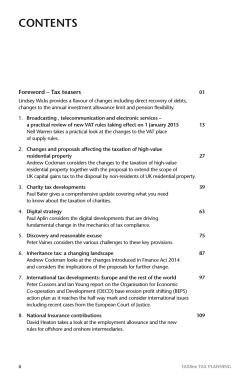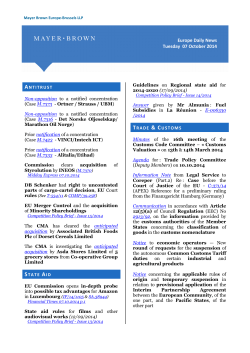
Taxation Policies: Evidence from Flat Tax vs. Progressive Tax
RSP • No. 45 • 2015: 200-210 R S P ORIGINAL PAPER Taxation Policies: Evidence from Flat Tax vs. Progressive Tax Pathways Narcis Eduard Mitu* Abstract The challenging economic times are not yet over. Therefore, after a brief history of the evolution of tax, in this Article we tried to point out the current challenges related to the tax system. The study performed made us conclude that the actual problem of taxation today is not necessarily related to the method of taxation, progressive or proportional, but to the dimension of the resources that can be drawn to the budget so that the degree of population’s satisfaction would be as high as possible. The decision to progressively or proportionally tax is a matter primarily of ethics and, complementarily, of efficiency. Keywords: taxation, tax equality, tax equity, flat tax, progressive tax. * Associate Professor, PhD, University of Craiova, Faculty of Economics and Business Administration, Public Finances specialization, Phone: 0040251411317, E-mail: mitunarcis@yahoo.com. 200 Taxation policies: Evidence from Flat Tax vs. Progressive Tax Pathways Introduction The tax and taxation have been and are subjects that capture citizens’ interest to the greatest extent. Because of this, along the various historical stages of the evolution of human society, many schools of currents of thoughts regarding their role and functions (Tulai and Șerbu, 2005; Jessua, Labrousse and Vitry, 2006; Drăcea, Mitu and Drăcea, 2009; Buziernescu, 2009). The contemporary tax systems are a result of the development of human civilisation. Their evolution was reflected in the development of the ideological and political currents, social and economic structures and scientific researches in the last few centuries, influencing each other. Evolution of tax systems The early stage of the evolution of tax systems ends at the beginning of the 16th Century. This long period when the tax relations have evolved very slowly was characterised by tax structures specific to the agricultural civilisation. Characteristic to the starting period it was the fact that, amid the huge social inequalities, tax liabilities were established and distributed arbitrarily, being different according to the size and level of each administrative-territorial unit. The lack of regularity of the tax collection was also a defining feature (Mitu, 2008: 116-117) The liberal stage in the evolution of tax systems begins with the late 16th Century and ends in the second half of the 19th Century. In this time interval, significant social mutations and economic transformations occur. Tax structures begin to reflect the occurrence of property and capitalist-type production, which determine the emergence of new social classes: agricultural and industrial labourers, bourgeoisie. Representatives of the forming social classes emerge increasingly more often, who formulate critiques on the tax privileges the nobles enjoyed (the ruling class did not owe or paid very small taxes), noted in a number of writings on tax issues that studied the taxes in terms of legality, legitimacy and social influence (Francois Quesnay, Montesquieu, Jean Jacques Rousseau, Adam Smith, Jean Baptiste Say, David Ricardo etc.). The main principles promoted in this period supported the minimisation of public expenses (they had to be directed to financing the services that could not be provided by the private entrepreneurs) and the neutrality of tax. In view of the liberal period, the tax had one function, that of acquiring for the state the means for funding its expenses. In the 19th Century, the political concept of the bourgeoisie in power caused rapid changes in the tax structures. The policy of the liberal states began to emphasise the predominance of direct taxes, and in particular on the introduction of the income tax, considered the main source of the budget construction. The modern stage begins after 1870, when the foundations of the process of concentrating the microeconomic structures are established. Thus, in the 20th Century, significant mutations in the tax policy promoted by the world states were noted, as a result of the two world wars; of the outbreaks of strong economic crises and drainage of their effects; of the unprecedented development of infrastructure; of the consolidation and modernisation of the administrative apparatus; of the industrial development; of the environmentalist movements, etc. Therefore, even since the beginning of the century, instead of the actual taxes, dominant in the Middle Ages, as well as in the early stages of the modern era, personal taxes have been established. Established on the income or profit, on the property or patrimony, personal taxes made it possible to differentiate the tax 201 Narcis Eduard MITU burden, depending not only on the nature and dimension of the taxable matter, but also on the civil status of the taxpayer: natural person or legal entity. The increasingly greater need for public financial resources made it necessary to establish new direct and indirect taxes and to transform certain exceptional taxes into permanent tax revenues. Repeated and many changes occurred in the structure and level of taxes, as well as in the manner of establishing and paying them. Thus, in the first decades of the last century, in some countries there was only one income tax that applies both to natural persons and legal entities, while in others there were distinct regulations adapted to the specificity of the two categories of taxpayers. Direct taxation was preferred, normally proportional, because it was considered that it responds better to the principle of equality before the laws. Frequently, taxation was done either at different rates depending on the nature (source) of the taxable object: financial properties, agricultural exploitations, securities, commerce, industry, banks, free professional services, salaries and pensions, etc. During the period between the two world wars, unions and left wing political powers campaigned for the participation of the population to financing the permanently growing public expenses, in relation to the contributing ability of each social category. Therefore, the following were enacted: non-taxable minimum wage, taxation of the incomes in progressive rates by instalments, tax reductions for certain social duties (people who are taxpayer’s dependents and so on) and aids or pensions for sickness, disability, etc. The redistribution of income in favour of the disadvantaged social groups (unemployed, pensioners, families with many children, disabled individuals, etc.) through tax and budgetary instruments enjoyed for a while the support of the Keynesian doctrine followers (Minea and Costaș, 2006: 17), the interventionist views becoming a state policy in many countries. After the economic crisis of the ‘70s, a long line of economists (Milton Friedman, Friedrich Hayek, David D. Friedman, Gary Becker, Murray Rothbard, James M. Buchanan, Vernon L. Smith, etc.), creators of the modern liberal doctrine (libertarianism) have pleaded for the withdrawal of the state from the economic activity, the renunciation of using the taxes as an instrument of intervention in the economy, the replacement of the progressive income taxation of natural persons with proportional taxation, the reduction of the taxation rates, etc. (Mitu and Mitu, 2012: 22) Currently, one of the important topics of discussion and analysis is given by the dispute regarding two tax systems namely that using the proportional share and that based on the progressive rates (Epstein, 1985: 297-303). Tax equality and equity The taxation in proportional rates (uniform taxation or with a "flat rate") expresses a manifestation of the principle of equality to taxes (Mitchell, 2005), maintaining a constant ratio between income and tax, but at the same time, it breaches the principles of tax equity because it does not take into account the fact that the contributory power increases along with the increase of incomes achieved by various social groups. As a concept, tax equity means social justice in terms of taxes (Văcărel, Bistriceanu, Anghelache, Bodnar, Bercea, Moșteanu and Georgescu, 2003: 361). When one resorts to the spirit of justice for distributing the tax burden between the members of the society, one should distinguish between the concept of equality to the tax and the concept of equality through the tax. 202 Taxation policies: Evidence from Flat Tax vs. Progressive Tax Pathways The equality to tax implies that taxation is done in the same way, for all natural persons and legal entities, regardless of the place where they reside or have their registered offices. Basically, there should be no differences of tax treatment from one area to another in a tax jurisdiction. Taxation must also be done in the same way for all economic activities, regardless of how they are organisation or operate. Equality through tax requires the differentiation between tax burden from one individual to another, depending on a number of economic and social criteria, including: the absolute size of the taxable matter, the personal situation of the taxable subject, the nature and origin of incomes (Matei, Drăcea, Drăcea and Mitu, 2013: 190). Practically ensuring the tax equity involves the cumulative fulfilment of the following conditions (Văcărel et al, 2003: 361): a) establishing a minimum non-taxable income (enactment of tax exemption of a minimum income that would allow the satisfaction of the strictly necessary living needs). This condition can be applied only to direct taxes; b) differentiating the tax deed related to each taxpayer by taking into account the contributory power it has, meaning the dimension of the income and property subject to taxation along with its personal situation (civil status, age, degree of handicap, with or without dependants, etc.) must be taken into account; c) ensuring the comparability of tax burden between the individuals of the same social group who have equal contributory power and between social groups taken as whole, with the same contributory power; d) taxation should be general, meaning it should encompass all social groups achieving incomes from a certain source or which have a certain type of property, except for those that are below the non-taxable minimum; Whether tax fairness is met or not also depends on the type of tax rates used. Taxation in fixes amounts is a system that ignores the income or the taxpayer’s property and their personal condition. Today, in Romania as in many other countries, this system is practiced especially in the case of the property tax (owning movable or immovable properties) (for example, the tax on buildings with reinforced concrete frames or brick external walls, with facilities is of 935 RON/sqm; the tax on the land located within the town in the zone A, rank zero is of 10,353 RON/ha; the tax on mopeds, scooters, motorcycles and cars with the engine capacity of up to 1,600 cc is of 8 RON/tranche of 200 cc or fraction thereof, etc.). Taxation in percentage rates has three forms: taxation in proportional rates, in progressive rates and in regressive rates. 1. Taxation in proportional rates (uniform taxation or with “flat rate”) is a form of direct manifestation of the principle of equality to taxes. It is characteristic that the same tax rate applies irrespective of the size of the taxable object, permanently keeping the same proportion between the tax and the volume of the taxable matter. Currently, in some countries, taxation in proportionate rates is used both for direct taxes and in the case of indirect taxes if (for example, when determining the income tax, profit tax, the value added tax, etc.). 2. Taxation in the progressive rates involves that along with increasing the incomes (the property), the size of the tax rate shall also increase, so that the tax shall grow faster than the taxable object. The progression rates may increase either steadily, or variably. In the financial practice, progressive taxation has two variants: taxation in simple (global) progressive rates and taxation in compound progressive rates (by instalments). Taxation in simple progressive rates (rarely used in practice) has the characteristic of applying to the state tax rate on the entire taxable matter incumbent or belonging to a taxpayer. In this situation, the tax rate shall be greater within the limits of the 203 Narcis Eduard MITU progressiveness established by law as the income or the property shall be higher. The due tax is determined by the product of the size of the taxable object (income, property) and the tax rate related to its level (i.e. as of December 13th, 2015, in Romania, the rate related to the tax on the incomes from gambling is of 1% applied on the net income not exceeding the equivalent of 15,000 EUR; the gambling incomes exceeding the equivalent of 15,000 EUR is taxed by 16% and incomes higher than 100,000 EUR are taxed by 25%). Although it contributes in meeting the equity in the field of taxes, the taxation in simple progressive rates however has some shortcomings. (Văcărel et. al., 2003: 363) underlines that this way of taxation disadvantages the taxpayers who achieve incomes the level of which is above the limit immediately higher than that where a certain rate operates. Taxation in compound progressive rates (by instalments) has the peculiarity that it proposes the division of the taxable matter into several instalments (parts), a certain taxation rate being related to each income (property) instalment. By summing up the partial taxes obtained for each individual instalment of income (property), we determine the total tax payable, which is the responsibility of a taxpayer (for example, in Romania, for the transfer of buildings of any kind with their related lands from the personal patrimony, as well as for the transfer of lands of any kind without any buildings, acquired in a period of up to 3 years, the value of the taxation rate is 3% up to and including the amount of 200,000 RON and for what exceeds to 200,000 RON, 6,000 RON + 2% calculated at the value exceeding 200,000 RON). 3. Quite rarely, in the tax practice of some states, the taxation in progressive rates is also encountered. Its characteristic is that the tax weight is inversely proportional to the dimension of the income, property or expenses incurred. In other words, as the amount of the taxable matter increases, the level of the taxation rate decreases. Flat tax versus progressive tax Progressive taxation or uniform taxation? This is one of the dilemmas that occupies increasingly more the imagination of economic specialists. From the interaction of the efficiency criterion (as it is better) with the ethical one (as it is right), answers may arise, likely to tip the scale in favour of one of these systems. Romania has the advantage of applying the two taxation systems, both having weaknesses or strengths, which we shall try to put into discussion below. Flat tax, as it is known in the Anglo-Saxon literature, is a representative form of dealing with the taxation system in proportional percentage rates. Flat tax is not a novelty in the tax field, but it only seems so, after a century of progressive income taxation. The embryo of this system existed even since the Middle Ages. In feudal Europe, taxation consisted in the land owners taking over a certain proportion of the agricultural production of those who worked it, in kind. “Tithing” seems to be the ancestor of tax, of today’s flat tax. Theoretically, the tax system based on the flat tax has its roots in the writings of the “father of capitalism”, Adam Smith. Later, the idea of a proportional taxation opposite to the progressive one was relaunched in the '60s when Milton Friedman (1962) suggested a federal tax of 23.5% for the USA. Friedrich A. Hayek (1960) also brought arguments against the idea that progressive taxation would be essential to ensure the redistribution of incomes in favour of the poor ones. However, those who deepened and developed this topic were the American Professors Robert Hall and Alvin Rabushka from the Hoover Institute. The tax reform proposed by Hall and Rabushka (1985: 465-480) is based on a single taxation rate for all types of income. The characteristics of the tax system imagined 204 Taxation policies: Evidence from Flat Tax vs. Progressive Tax Pathways by the two authors are given by the fact that: a certain type of income is taxed only once (double taxation is not permitted); taxation is done evenly at the level of incomes, meaning without any differentiation between the various types of income; the system also sets a consumption taxation (so that new investments are exempted from the taxation base). In our country, the model proposed by Hall and Rabushka is not applied as it does not fully meet the characteristics of the flat tax model. The taxation system practiced allows double taxation (Tulai and Schiau, 2013: 327-332), and the uniqueness of the rate manifests only within certain types of taxes, yet there being plenty of exceptions to the rule. The supporters of the flat taxation system emphasise as first advantage the possibility of adopting a lower level of taxation, likely to stimulate saving, capital formation and entrepreneurship activity, which can create the potential to enhance the economic performance. In today’s economy, which is strongly globalised, the capital and the jobs migrate to the areas where the tax pressure is as low as possible. However, this is not a disadvantage that can be counted in favour of the flat rate, unless to the extent where the level of the rate is lower compared to that of other states of the same political, economical and geographical perimeter. As such, it is not the flat tax in itself as tax system, but a correct, optimal taxation rate (whatever that may be) is the element generating advantages. Let us imagine the situation of Romania, under the conditions where the flat tax would no longer be 16%, but 40%. Certainly, the extremely high level would turn into a big disadvantage. There may also be other elements of discussion when it comes to the issue of the optimum of the flat taxation rate. The followers of this tax system say that such taxation contributes to encouraging production and providing greater tax collections for the government. But increasing the state budget levies should be carefully managed so as not to attract the artificial extension of the state’s role in the economy, which would ultimately lead to leaving the liberal doctrine whose area the promoters of the “flat tax” system originate. A high level of financial resources available to governments does not always have positive effects also on the taxpayers. From this point of view, the reasoning of Hume known in the socioeconomic theory as the “tragedy of commons” (Edwards, 2001: 253257) applies to public money. In most cases, public money is dealt with as resources without an owner, which become subject of the rent-seeking type pillage. In this sense, Milton Friedman said that “very few people spend other people’s money as carefully as they spend their own.” If the flat rate taxation responds perfectly to the principle of equality to tax, the same cannot be said when the it comes to equality through tax. Man is an empathetic being (Calvet and Alm, 2013: 1-40). We like to brag about it. Yet, when it comes to taxes, the empathy of some disappears and equality to tax is preferred, instead of equality through tax. But inequality is a constant in economic life, just as it is also in the everyday life. The access to resources and information is different and many times inequitable (Olimid, 2014: 77). We are born with different IQ’s, the health degree varies from one person to another, etc. Certain individuals or social groups have greater needs, objectives than others. In this case, the question that we should ask is: Are we, as individuals, prepared to bear an accordingly (increased) greater tax rate when we get higher incomes, which would compensate a lower tax paid by an individual objectively unable to obtain incomes that are similar to those obtained by us? From this point of view, the answers shall probably 205 Narcis Eduard MITU be different (Schwartz and Orleans, 1967; Baldry, 1986; Alm, McClelland and Schulze, 1992; Feld and Frey, 2007; Coricelli et al., 2010). The followers of the flat tax system shall answer negatively. Surely, behind the negation there are also objective reasons. The argument used most commonly is that the system of progressive rates can encourage laziness. However, this phenomenon can be countered by practicing some less permissive social protection systems. Another argument used often in favour of the flat tax is that this system reduces the tax burden (tax pressure) of those who achieve low incomes. But this favourable argument is not a mandatory feature of this system and is only partially true. We can take the example of a hypothetical and simplified situation where there are two individuals X and Y who achieve taxed incomes at a flat rate of 50%. The individual X achieves a taxable income of 1,000 monetary units, while the individual Y achieves taxable incomes of 10,000 monetary units. After paying the income tax, the individual X has 500 monetary units available, and the individual Y has 5,000 monetary units available. Even if mathematically the tax pressure is equal (50%), the affordability degree is obviously another. Certainly, the individual Y shall bear more easily the tax burden compared to the individual X. In Romania, according to the data of the National Institute of Statistics (INS: 05 June 2014), in 2013 the salaries and the other incomes related thereto were the most important source of incomes, with the largest share in the total incomes of households (51.2%). Thus, in a study conducted in 2013 by the National Institute of Statistics (the last of this kind to the date of writing this Article) and called “Distribution of Employees by Groups of Salaries” (http://media.hotnews.ro/media_server1/document-2013-052014840367-0-repartizarea-salariatilor-grupe-salarii-realizate-luna-octombrie-20121. pdf) it results that in 2012, 5.0% of the number of employees who worked at least 23 days full-time have achieved under and at the level of the minimum wage; 46.7% of the employees have achieved gross salaries ranging between 701 and 1,500 RON; 32.1% between 1,501 and 3000 RON; 11.0% achieved gross salaries between 3,001 and 5,000 RON, and 5.2 % achieved gross salaries of over 5,000 RON. Therefore, 16.2% of the population obtained salary incomes lower than 3,000 RON, while the 83.3% obtained incomes under 3,000 RON. In the given situation, a system of compound progressive taxation having for example 1,500 RON as upper limit of the first income instalment and a tax rate of 14%, the second instalment ranging between 1,501 RON and 3,000 RON and a rate of 16%, and the third instalment being the incomes that exceed 3,001 RON taxed by 30%, would positively affect 83.8% (5.0%+46.7%+32.1%) of those who obtain salary incomes and negatively only 16.2%, under the conditions where the incomes collected to the budget remain at the same level. To exemplify, based on the aforementioned figures, we shall do the following simplified hypothetical calculation of a sample of 1,000 employees: 206 Taxation policies: Evidence from Flat Tax vs. Progressive Tax Pathways Table 1. Comparative approach: flat rate vs. progressive rates Flat rate Income instalment (RON) Number of employees 0 1 0 – 1.500 1.5013.000 Over 3.001 Compound progressive rates Average income/salary x taxation rate = tax to be paid (RON) 2 Total tax (RON) 517 321 162 3=1x2 Average income/salary x taxation rate = tax to be paid (RON) 21 31=1x21 1.200 x 16% = 192 99.264 1.200 x 14% = 168 86.856 2200 x 16% = 352 112.992 1.500 x 14% = 210 103.362 4.200 x 16% = 640 Total tax (RON) 700 x 16% = 112 108.864 Total tax to be paid for an average income of 2200 = 210+112= 322 lei 1.500 x 14% = 210 131.220 1.500 x 16% = 240 1.200 x 30% = 360 Total tax to be paid for an average income of 4200 = 210+240+360= 810 lei TOTAL 321.120 321.438 If we also add to this example some of the conclusions of Voinea and Mihăescu (2009: 19-41) which, in summary, they refer to the fact that: the higher the gross wage, the higher the flat tax gains; the distribution of gains is very unequal: (10% of the total employees received 40% of the total flat tax gains (in relative terms, the average flat tax gain of an employee was 3.73% of their net wage, while only 2% of the total employees gained more than 10% of their net wage); the richest 20% of those who achieved incomes had true gains as a result of the flat rate; we may easily observe that it is not the “flat tax” taxation system in itself likely to ease the tax burden, but the level of the taxation rates regardless of the tax system adopted. As such, the flat tax taxation system may cause the reduction of the tax burden on taxpayers, but it is equally true that reducing the tax burden may also take place within the progressive taxation system (Marinescu, 2008). Clearly, if we refer to Romania, 16% is even less than 18% as the minimum wage tax rate was in 2004, and even than 40% the peak which it reaches. Instead of the 207 Narcis Eduard MITU instalments of 18%, 23%, 28%, 34% and 40%, the taxation of salaries is done as of the beginning of 2005 by 16%. On the other hand, a progressive tax regime (with instalments ranging for example between 5% and 16%) may be less burdening than the proportional one. Everything consists in wisely choosing the income instalments and related rates. The empirical results indicate that the higher the income level is, the lower the income elasticity of consumption is (Voinea and Mihăescu, 2009: 39). In other words, the higher the level of incomes we have, the more we have the possibility and tendency to consume. Increasing the consumption is one of the factors that positively influences the national economies, with one condition: the results of the consumption growth to be internalised (to remain within the borders of the economic system that generated it). Unfortunately, in the context of social polarisation that currently occurs in Romania in a pretty obvious way, those who benefited the most from the introduction of the flat rate taxation system of 16% (taxpayers achieving high incomes) have consumption habits that cannot enable an internalisation of the additional income. Most often, they go for important shopping abroad, they spend their holidays in other geographical areas, even the offices of their businesses begin to migrate outside the borders and the examples may continue. However, the purpose of the tax system adopted must be to create a strong middle social class (feature of all countries with developed economy and high social protection) and not to divide the society to extremes: Too rich and too poor. In order to complete the picture of the progressive rate taxation analysis versus flat rate taxation, we should note that the area of applicability of the “flat tax” system is much lower than that of the system of proportional rate, the latter generally applying in those countries with an emerging economy and a population polarised in terms of the resources they have. Ranked according to the year when they adopted the system, the jurisdictions and countries where the “flat tax” operates are: Jersey (1940); Hong Kong (1947); Guernsey (1960); Estonia (1994); Latvia (1995); Lithuania (1996); Russia (2001); Serbia (2003); Ukraine (2004); Iraq (2004); Romania (2005); Georgia (2005); Turkmenistan (2005); Kyrgyzstan (2006); Macedonia (2006); Iceland (2007); Mongolia (2007); Kazakhstan (2007); Montenegro (2007); Albania (2008); Bulgaria (2008); Mauritius (2009); Belarus (2009); Hungary (2011) (Drăcea, Mitu and Drăcea, 2011, 99-155). Among the European Union countries that have a flat tax for taxation, Latvia has the biggest rate, 25%, while Bulgaria is on the opposite side, the taxation rate here being 10%. It should also be noted that Slovakia, which adopted in 2003 the flat tax system, faces a strong degradation of public finances, it has not reintroduced, after ten years, the progressive taxation system (Schiau & Moga, 2009: 346). Conclusions After the analyses we have done, we consider that the actual problem of taxation today is not necessarily related to the method of taxation, progressive or proportional, but to the dimension of the resources that can be drawn to the budget to that the degree of population’s satisfaction would be as high as possible. In other words, we must be more interested in the overall level of taxation, than in the nature of taxation. In conclusion, the decision to progressively or proportionally tax is a matter primarily of ethics and, complementarily, of efficiency. Unfortunately, the rules of the democratic game stimulate the governors to maximise most often the level of public expenditure (Gîrleșteanu, 2009), even at the 208 Taxation policies: Evidence from Flat Tax vs. Progressive Tax Pathways expense of economic development, as the political factor requires that, in a relatively short cycle as the election one, it meets the needs related rather to favouring the main financers of the election campaigns (those who of high incomes) than to the macroeconomic development. Therefore, the tax regime is inevitably subordinated to the discretionary budgetary needs and political interests. Thus, the degree of taxation and the tax pressure are not a result of the profitability calculations (a purely economic result), but rather a result of calculations, interests and political programs (an electoral result). It is not the economic calculation that decides the protection level and the tax rate, but the political interests and potential electoral success of various arrangements. Consequently, taxation is not an intrinsic problem of the market economy, but one of the statist political system (Marinescu, 2008). The centre of gravity of the discussions on taxation must be moved from the problems related to how taxation is done to the problems related to its dimension related to the affordability degree of each taxpayer and to the correct and efficient investment (spending) of what is collected to the budget. The taxes collected by the state must be in relation to the quantity, but particularly the quality of the services provided to citizens. If the degree of transparency of how the collected resources are used shall be higher, then taxpayers shall also accept with greater understanding the need for a taxation differentiated depending on the level of incomes and property. However, as Milton Friedman said, “if we want to do good with other people’s money first we have to take it from them”, because there is not a miraculous solution for the financial problems of a government. If it needs money, a government must procure it by taking the taxes from the citizens, but the tax mechanism should be well adjusted so as it does not generate centrifugal forces that aim to remove increasingly more the social classes, inevitably leading to social polarisation, but centripetal forces that tend to approach the centre and can consolidate the middle class: the foundation of progress. References: Alm, J., McClelland, G. H., Schulze, W. D. (1992). Why do People Pay Taxes? Journal of Public Economics, 48 (1): 21-48. Baldry, J. C. (1986). Tax Evasion is not a Gamble. Economics Letters, 22: 333–335. Buziernescu, R. (2009). Fiscalitate, Craiova: Universitaria Publishing House. Calvet, R., Alm, J. (2013). Empathy, Sympathy, and Tax Compliance, Working Paper 1310, Tulane Economics Working Paper Series: 1-40. Coricelli, G., Joffily, M., Montmarquette, C., Villeval, M. C. (2010). Cheating, Emotions, and Rationality: An Experiment on Tax Evasion. Experimental Economics, 13: 226– 247. Drăcea, M., Mitu, N. E., Drăcea, R. (2009). Fiscalitate comparată, Craiova: Universitaria Publishing House. Drăcea, M., Mitu, N. E., Drăcea, R. (2011). Sisteme fiscale comparate, Craiova: Universitaria Publishing House. Edwards, J. R. (2001). Taxation, Forced Labor, and Theft: Comment, The Independent Review, vol. VI, 2: 253-257. Epstein, R. A. (1985). Takings: Private Property and the Power of Eminent Domain, Cambridge University Press: 297-303. 209 Narcis Eduard MITU Feld, L. P., Frey, B. S., (2007). Tax Compliance as the Result of a Psychological Tax Contract: The Role of Incentives and Responsive Regulation. Law & Policy, 29 (1): 102-120. Gîrleşteanu, G. (2009). Organizarea generală a administraţiei, second edition, Craiova: Sitech Publishing House. Hall, R., Rabushka, A. (1985). The Route to a Progressive Flat Tax, Cato Journal, vol. 5, 2: 465-480. National Statistical Institute (INS), 05 June 2014, official source. Retrieved from: http://www.insse.ro/cms/files/statistici/comunicate/com_nuale/venituri%20si%20c heltuieli/ABF_2013r.pdf. Jessua, C., Labrousse, C., Vitry, D. (2006). Dicționar de științe economice, Bucharest: Arc Publishing House. Marinescu, C., (2008). Butaforia optimului fiscal: impozit progresiv vs. cota unică, Centrul pentru Economie şi Libertate. Retrieved from: http://www.ecol.ro/content/butaforia-optimului-fiscal-impozit-progresiv-vs-cotaunica. Matei, G., Drăcea, M., Drăcea, R., Mitu, N. E. (2013). Finanțe publice, Craiova: Universitaria Publishing House. Minea, M. Ș., Costaș, C. F. (2006). Fiscalitatea în Europa la începutul mileniului III, Bucharest: Rosetti Publishing. Mitchell, D. (2005). A Brief Guide to the Flat Tax, Backgrounder No. 1866. Mitu, N. E. (2008). Finanțe publice, Craiova: Universitaria Publishing House. Mitu, N. E., Mitu, I. E., (2012). Proceduri fiscale, Craiova: Sitech Publishing House. Olimid, A. P. (2014). Civic Engagement and Citizen Participation in Local Governance: Innovations in Civil Society Research. Revista de Științe Politice. Revue des Sciences Politiques, 44: 73-84. Repartizarea salariaților pe grupe de salarii realizate în luna octombrie 2012. Retrieved from: http://media.hotnews.ro/media_server1/document-2013-05-20-14840367-0repartizarea-salariatilor-grupe-salarii-realizate-luna-octombrie-2012-1.pdf. Schiau, L., Moga A., (2009). The Flat Tax Effects – Theoretical and Empirical Evidence in Western And Eastern European Countries, Annals of Faculty of Economics, University of Oradea, Faculty of Economics, 3 (1): 343-348. Schwartz, R., Orleans, S. (1967). On Legal Sanctions. University of Chicago Law Review, 34: 282-300. Tulai, C., Schiau, L. (2013). Impactul cotei unice asupra PIB în țările din estul Europei. In International Conference: Sustainable Development in Conditionas of Economic Instability - 2nd edition, Bucharest: Cibernetica MC Publishing House, pp. 327332. Tulai, C., Șerbu, S. (2005). Fiscalitate comparată și armonizări fiscale, Cluj Napoca: Casa Cărții de Știință Publishing House. Voinea, L., Mihaescu, F. (2009). The impact of the flat tax reform on inequality – the case of Romania, Journal for Economic Forecasting, 4: 19-41. Article Info Received: February 10 2015 Accepted: March 18 2015 210
© Copyright 2025









